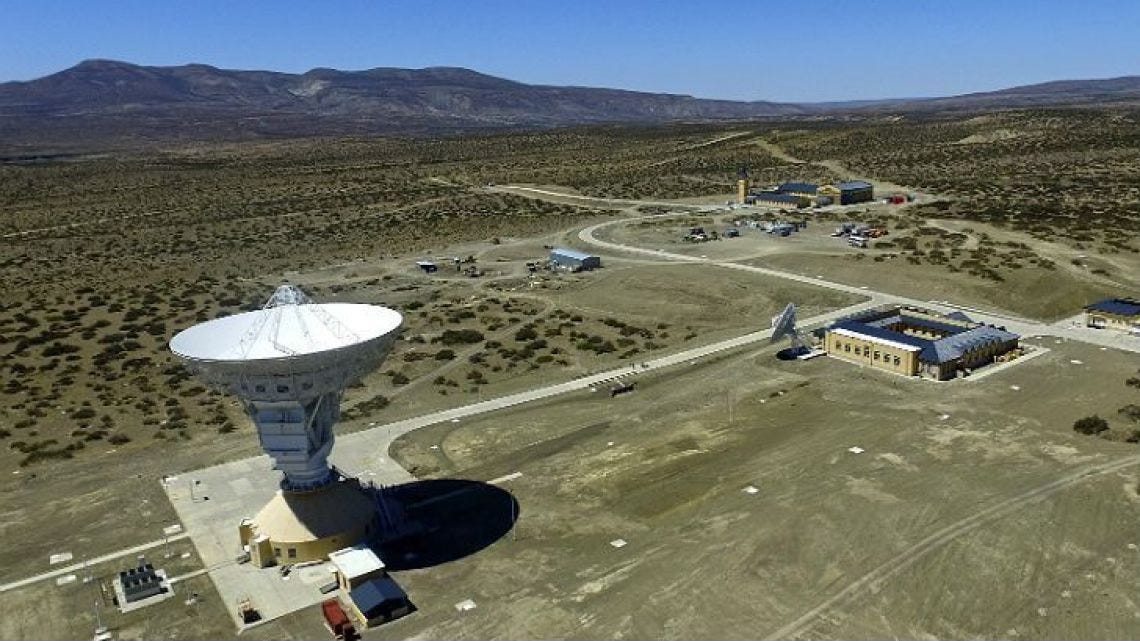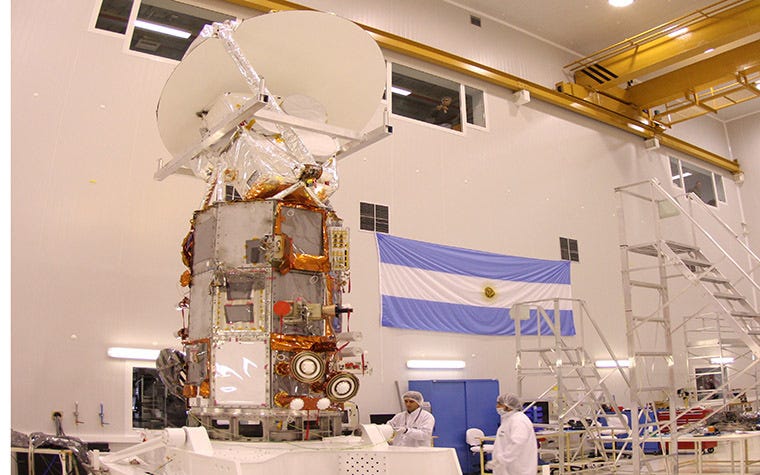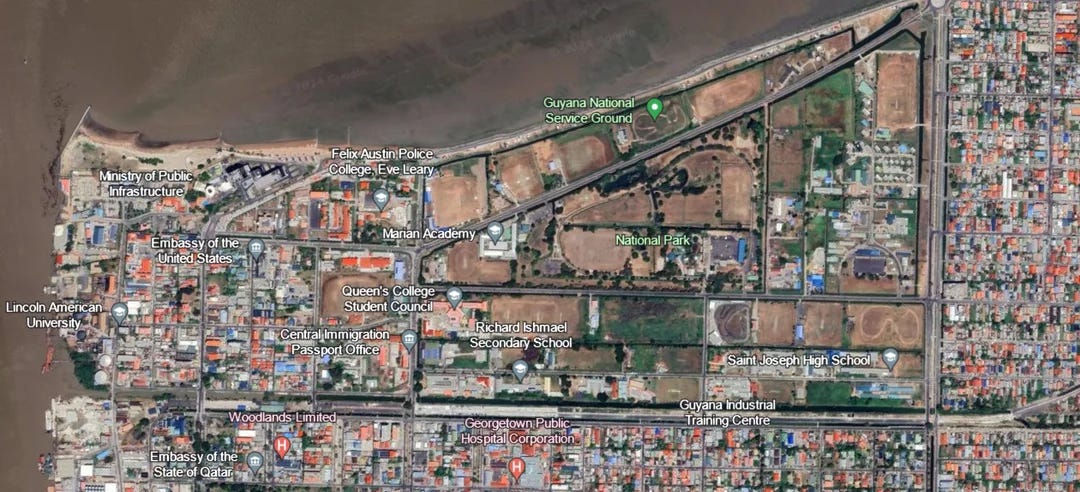Latin America Space Roundup: 10 to 24 April 2025
A summary of all the space news in Latin America over the past two weeks, brought to you by AzurX
Project Latitude Zero: Pioneering Ecuador’s Path to the Stars — A new spaceport initiative placing Latin America on the global launch map. [Source]
Welcome to the inaugural edition of the Latin America Space Monitor by AzurX — your trusted resource on the region’s accelerating role in the global space economy.
As Latin America steps forward with sovereign launch capabilities, advanced satellite systems, data-driven environmental solutions, and resilient space-based infrastructure, it's clear that the region is no longer on the periphery of the space conversation - it is positioning space as a pillar of its broader economic strategy and becoming a key player. This shift is not only reshaping national priorities it's creating new markets, attracting foreign investment, and redefining the region’s role in global supply chains and geostrategic alliances.
From Brazil’s long-standing aerospace heritage and satellite launches, to Mexico’s emerging role in space tech entrepreneurship, to Argentina’s strides in Earth observation and data analytics, Latin America is crafting a unique, resourceful space identity. This renaissance is fueled by rising regional demand for space-enabled solutions in agriculture, disaster response, environmental monitoring, and connectivity, sectors vital to the continent’s development.
At AzurX, we believe emerging markets are where the future of space is being shaped. Our flagship Monitors focus on the Middle East and Southeast Asia. Through this Monitor, we aim to illuminate the people, policies, and projects propelling Latin America's space ambitions, offering insights for those looking to understand or engage with this dynamic and underreported frontier.
The following are the major space developments in the Latin America region tracked by Latin America Space Monitor over the past two weeks:
U.S.-China Space Rivalry in Latin America
Chile at the Center of U.S.-China Geopolitical Space Dispute
The escalating geopolitical rivalry between the U.S. and China is increasingly impacting Latin America's scientific and technological partnerships, with Chile becoming a recent focal point. U.S. ambassador nominee Brandon Judd expressed intent to limit China’s involvement in Chilean projects—particularly in space and technology—during his Senate confirmation, citing concerns over strategic assets like the Transitory Object Monitoring (TOM) astronomical project. The Chinese embassy in Chile condemned the remarks as hegemonic and likened them to a modern-day Monroe Doctrine, defending the TOM project as compliant with Chilean law and intended solely for scientific research. The controversy reflects a broader trend of U.S. efforts to counter Beijing’s expanding technological footprint in South America, as seen with Argentina’s review of a Chinese-operated space base in Patagonia. Meanwhile, China accuses Washington of applying double standards, highlighting that similar U.S.-funded scientific installations in Chile, such as the Vera Rubin Observatory, have not faced equivalent criticism. Chile’s ongoing review of the TOM project underscores the pressure regional governments face in navigating science diplomacy amid intensifying great-power competition in space-related infrastructure.
Report: China-Chile Observatory Plan Likely Illegal Under Chilean Law
Adding further fuel to the U.S.-China spat on space cooperation with Latin American countries, the proposed joint space observatory at Cerro Ventarrones in Chile’s Atacama Desert, developed by China’s National Astronomical Observatory and Chile’s private Universidad Católica del Norte, has been halted due to legal constraints under Chilean law that prohibit private entities from entering international agreements on astronomical observation. The project, which drew scrutiny from the U.S. over its potential dual-use military applications—particularly satellite tracking—was viewed by China as part of a broader global surveillance initiative serving national strategic needs. Chile’s Foreign Ministry emphasized that such ventures must be pursued either through state-to-state channels or via public institutions like the University of Chile and raised concerns about the legality of using public land for the observatory. While not formally canceled, the project has been placed under review, with growing pressure from the U.S. highlighting the broader geopolitical stakes in Latin America’s scientific infrastructure. The case underscores the urgent need for Chile to adopt a clear national space strategy balancing scientific collaboration with national security and sovereignty in an increasingly contested geopolitical landscape.
China’s Expanding Space Infrastructure in Latin America Cause for U.S. Concern
China’s expanding space ambitions are placing Latin America at the center of its global strategy, as the region offers ideal geography for satellite tracking, deep space observation, and space infrastructure development. A prominent example is the Cerro Ventarrones Astronomical Park in Chile's Atacama Desert, a $81 million joint initiative between China’s National Astronomical Observatory and Chile’s North Catholic University. While framed as a scientific collaboration, experts warn the facility could also enable satellite tracking and signal interception for non-civilian purposes. This mirrors concerns over other Chinese ground stations in the region, such as the Espacio Lejano Station in Argentina, which operates under a 50-year agreement and is controlled by the PLA’s Strategic Support Force. Similar agreements in Venezuela and recent cooperation efforts in Brazil highlight the growing influence of Chinese space infrastructure in South America. Analysts caution that technologies provided by firms like China Great Wall Industry Corporation (CGWIC) have dual-use potential, blending scientific and military applications, which may deepen host countries’ long-term dependency on Beijing. As China moves forward with space projects including its planned 1-km-wide orbital solar station and International Lunar Research Station, Latin America’s integration into these initiatives raises significant strategic, technological, and sovereignty implications for the region.

In U.S.-China Space Rivalry, Latin American Countries Don’t Necessarily View U.S. as a Better Space Alternative
As U.S.-China rivalry intensifies, Latin America’s long-standing space collaboration with Beijing is increasingly under pressure from Washington, which seeks to curb China's influence in the region, especially in strategic scientific sectors like satellites and deep space observation. Despite U.S. objections, Latin American countries—citing development needs and technology transfer benefits—are unlikely to abandon Chinese partnerships without credible alternatives from Washington. China’s state-driven, multilateral approach, exemplified by the Asia-Pacific Space Cooperation Organisation (APSCO) and BRICS space initiatives, offers satellite data sharing, ground station access, and capacity-building, contrasting with the U.S.’s fragmented and security-heavy strategy. Analysts argue that China’s willingness to transfer technology and invest in public goods has made it a more attractive partner to the region. The growing geopolitical contest is forcing Latin American governments into a delicate balancing act, which may ultimately drive them toward more diversified and autonomous space strategies, including deeper regional cooperation and selective partnerships with both superpowers.
Argentina Space Developments
Argentina Modernizes Satellite Communications Registration Regulations
Argentina has modernized its satellite communications framework through Resolution No. 58/2025, which replaces outdated regulations to streamline and unify procedures for managing both geostationary and non-geostationary satellite services. Issued by the Secretariat of Innovation, Science, and Technology, the updated Regulation simplifies administrative requirements for operators while maintaining essential oversight to coordinate radio frequency use and prevent interference. Satellite service providers must now comply with registration procedures outlined in prior legislation (including Decree No. 70/2023 and Resolution No. 12/2024), obtain ICT service licenses, and secure spectrum use authorizations. The Regulation also introduces the potential for a registration fee, reflecting Argentina's aim to balance regulatory clarity with operational accountability as it expands access to satellite-based ICT services.
Brazil Space News
Brazil and China Expand Longstanding Space Cooperation by Building Radio Telescope in North-East Brazil
Brazil and China have been working together on space research for nearly four decades. The partnership has already launched six satellites and is expanding into deep space observation, with a massive radio telescope under construction in northeastern Brazil. Watch the video here.
Globalsat Partners With Viasat For Brazil’s Railway Communications Services
Globalsat Brasil, in collaboration with Viasat, is spearheading a decade-long initiative to modernize Brazil's railway communications infrastructure for VLI Logística. This project entails deploying a hybrid satellite and LTE connectivity solution across over 1,800 kilometers of railway network in São Paulo, Goiás, and Minas Gerais. The enhanced communication system aims to support existing onboard technologies and facilitate the integration of advanced systems like Positive Train Control (PTC) and real-time fleet monitoring. By enabling direct communication between control teams and locomotive operators, the initiative seeks to improve operational efficiency, reduce transit times, and ensure compliance with safety standards, even in regions lacking LTE coverage.
Viasat Demonstrates D2H SATCOM in Brazil
Viasat has successfully demonstrated its direct-to-handset (D2H) satellite communication technology in Brazil, marking a significant advancement in connecting remote areas. Utilizing L-band frequencies and adhering to 3GPP Release 17 standards, the demonstration showcased two smartphones establishing direct satellite links without relying on terrestrial infrastructure. This technology holds promise for extending connectivity to Brazil's underserved regions, potentially transforming sectors like agriculture and transportation by enabling seamless communication for both consumers and IoT devices.
Brazil’s Competition Regulator Approves Acquisition of Hispasat by Spain’s Indra
Spanish defense company Indra’s €725 million ($824.75 million) acquisition of a majority 89.68% stake in Spanish satellite operator Hispasat from Redeia has been approved unconditionally by Brazil’s competition authority, CADE, following a swift review process. The deal, filed on 4 April 2025, was cleared in under two weeks, as authorities determined it would not produce significant horizontal or vertical integration effects. This strategic move consolidates Indra’s position in the satellite communications sector, aligning with Spain’s broader industrial policy: SEPI and CDTI, both state-linked entities, retain minority shares in Hispasat. The acquisition shifts Hispasat's ownership from Redeia, which bought the stake in 2019 as part of a diversification push and had since earned €96 million ($109.2 million) in dividends. The transaction reflects a national realignment of technological assets under a more defense and digital-focused Indra, potentially enhancing Spain’s sovereign capabilities in space infrastructure.
Brazil’s Embraer and Intelsat Partner to Equip E2 Jets with Multi-Orbit, High-Speed Inflight Connectivity
Brazil’s Embraer has partnered with Intelsat to offer factory-installed, high-speed inflight connectivity (IFC) on its E-Jet E2 aircraft. The system employs an Electronically Steered Array (ESA) antenna, capable of delivering up to 275 Mbps, providing passengers with reliable, low-latency internet access comparable to home broadband. The ESA antenna's low-profile design reduces aerodynamic drag, aligning with Embraer's sustainability goals. This collaboration marks Intelsat's first line-fit agreement, enhancing the passenger experience and offering airlines a competitive edge in onboard connectivity.
Quasar Space Confirmed at SpaceBR Show 2025
Quasar Space, a Brazilian company specializing in satellite imagery and artificial intelligence for agribusiness, will exhibit at the SpaceBR Show 2025 in São Paulo. The company provides high-resolution satellite data and AI-driven analytics to optimize agricultural, aquaculture, and agroforestry production. Quasar Space also offers monitoring solutions for climate, water quality, and forest areas, facilitating carbon credit generation and compliance with international standards. Their participation underscores the growing role of space-based technologies in sustainable resource management.
Brazilian Telecom and Satellite Industries Advocate for Delayed 6GHz Spectrum Auction Amid 5G Expansion
Major Brazilian telecommunications operators, including Telefônica, Claro, and TIM, are urging the National Telecommunications Agency (Anatel) to postpone the auction of the 6GHz frequency band until after 2026, preferably beyond 2030. These companies cite the significant investments already made in 5G infrastructure and the need for a more comprehensive understanding of the 6GHz band's potential applications. The satellite industry echoes these concerns, emphasizing the importance of ensuring that new spectrum allocations do not interfere with existing satellite services. This collective stance reflects the industry's cautious approach to spectrum management amid rapid technological advancements and the ongoing deployment of 5G networks.
Chile Space Developments
Chile’s Entel Explores Starlink Direct-to-Cell Satellite Services As Part of Its Roadmap
Entel, the Chilean telecommunications company, has approved a US$640 million investment plan for 2025—a 33.3% increase over 2024—to accelerate the expansion of its mobile, fiber optic, and digital services in Chile and Peru. The strategy, endorsed during the company’s recent shareholders' meeting, includes allocating US$431 million for Chile, with a major focus on enhancing 4G and 5G networks amid a shifting competitive landscape marked by the recovery of WOM, Claro’s consolidation, and speculation about Movistar’s exit. In Peru, Entel plans to invest US$208 million, including US$173 million for mobile service expansion, aiming to build on its rising market share, which reached 24.3% of total service revenue in 2024. Notably, Entel’s roadmap includes exploring next-generation digital services such as Starlink’s Direct-to-Cell satellite connectivity, underscoring the company’s pivot toward hybrid terrestrial-satellite solutions to stay competitive in underserved or remote markets. With capital expenditures projected to peak in 2025–26 before tapering off in 2027, Entel is positioning itself as a regional leader by leveraging aggressive network upgrades and strategic partnerships in a maturing yet rapidly evolving telecom ecosystem.
Chile and Philippines to Cooperate on Space Science and Astronomy
The Philippine Embassy in Chile, the Philippine Space Agency (PhilSA), and the Universidad de Chile's Department of Astronomy have initiated discussions to establish collaborative efforts in space science and astronomy. This prospective partnership aims to leverage Chile's advanced astronomical infrastructure and expertise alongside the Philippines' growing capabilities in space technology. Such collaboration is anticipated to enhance scientific research, technology development, and capacity building between the two nations, fostering mutual growth in the space sector. This initiative underscores the Philippines' commitment to expanding its international partnerships in space exploration and research.
UC Chile Joins ESA's PLATO Mission to Discover Exoplanets
The Pontificia Universidad Católica de Chile (UC Chile) has joined the European Space Agency’s PLATO mission, aimed at discovering Earth-like exoplanets. UC Chile’s Center for Astro Engineering developed PLATOSpec, a state-of-the-art spectrograph installed on the restored 1.52-meter telescope at the La Silla Observatory in Chile. This instrument will play a crucial role in identifying promising exoplanet candidates by conducting ground-based observations that complement the PLATO space telescope's data. The collaboration highlights Chile's growing contribution to international space research and its strategic importance in astronomical observations.
Cuba Space News
Cuba's Crackdown on Satellite Internet Access Highlights State Control Over Connectivity
In a recent enforcement action, Cuban customs authorities intercepted 20 Starlink satellite internet devices at Havana's José Martí International Airport, citing violations of national telecommunications regulations. Developed by SpaceX, Starlink offers satellite-based internet services that could circumvent Cuba's state-controlled provider, ETECSA. The Cuban government argues that unauthorized devices like Starlink disrupt the national radio spectrum and compromise service quality, though critics view such measures as efforts to maintain strict control over information access. This incident underscores the Cuban regime's ongoing efforts to regulate internet connectivity and restrict alternative access points that challenge its monopoly.
Guyana Space Developments
Guyana Adopts SpaceX’s Starlink for Telemedicine and Online Education
Guyana is leveraging SpaceX's Starlink satellite internet to enhance connectivity in its rural and hinterland regions. The government's initiative aims to support critical services such as the Guyana Online Academy of Learning (GOAL) scholarship program and telemedicine, thereby improving access to education and healthcare for remote communities. With plans to connect approximately 300 health facilities by June 2025, the rollout has already provided high-speed internet to 138 communities, facilitating online education and enabling healthcare professionals in remote areas to consult with specialists in urban centers, thus enhancing patient care and treatment outcomes.
Mexico Space News
U.S. Vessel's Unauthorized Entry into Mexican Marine Sanctuary Raises Surveillance and Sovereignty Concerns
The incursion of the U.S.-flagged vessel Red Rooster III into Mexico's Revillagigedo National Park, a UNESCO World Heritage Site and marine protected area, has sparked diplomatic and environmental concerns. Mexican authorities utilized advanced satellite monitoring systems, including Skylight and Global Fishing Watch, to detect the vessel's unauthorized activities, which included disabling its Automatic Identification System (AIS) to evade detection. This incident highlights the critical role of satellite surveillance in enforcing maritime sovereignty and the challenges nations face in protecting their ecological reserves from unauthorized exploitation.
Peru Space Developments
AFIN Warns That Congressional Proposals Will Hinder Internet Access for Millions of Peruvians
The Association for the Promotion of National Infrastructure (AFIN) in Peru has raised concerns that recent congressional proposals could impede internet access for millions. While specific details are limited, AFIN suggests that the proposed measures may adversely affect the deployment and operation of telecommunications infrastructure, including satellite communications, potentially widening the digital divide and hindering the country's digital development.
Other Regional Space News
South American Countries Provide Blueprint for U.S. Space Force’s International Partnership Strategy
The U.S. Space Force is preparing to release an “International Partnership Strategy” to deepen global cooperation in space, with particular emphasis on interoperability, shared capabilities, and mutual defense in the increasingly contested orbital domain. General Chance Saltzman, Chief of Space Operations, outlined the strategy at the 2025 Space Symposium, highlighting the urgent need to counter space threats posed by Russia and China through trusted multinational frameworks. A notable regional success story includes a Space Force unit in Tucson, Arizona, that has conducted 19 security cooperation initiatives with seven South American countries, helping install telescopes, operational centers, and enhancing space domain awareness through commercial technologies. This underscores South America’s growing relevance in the global space security architecture and positions the region as a critical partner in the U.S. effort to build a resilient and collaborative orbital infrastructure. Saltzman emphasized that cooperation with countries in South America and beyond is no longer optional but essential for safeguarding space assets and ensuring preparedness for future conflicts.
Presidents of Colombia and Uruguay Call for Regional Sovereign Access to Space
At the 9th CELAC Summit in Tegucigalpa, Honduras, President Yamandú Orsi of Uruguay and President Gustavo Petro of Colombia reaffirmed their commitment to advancing Latin American integration through strategic cooperation in renewable energy, pharmaceutical production, and high-tech sectors, including artificial intelligence, quantum mathematics, and space exploration. Both leaders emphasized the need to transition from rhetoric to implementation, with Petro advocating for Latin America's independent access to space capabilities rather than reliance on global powers. The discussion included ambitions to jointly develop space programs as part of broader technological sovereignty efforts. These initiatives, endorsed by regional figures such as former Uruguayan President José Mujica, align with CELAC’s revived agenda of 2023 but will require substantial investment, regulatory harmonization, and stronger intra-regional collaboration to materialize, particularly in the underdeveloped domains of regional satellite infrastructure and advanced space technology.
Be sure to catch up with space activities in the region in the next edition of Latin America Space Monitor’s space roundup!















